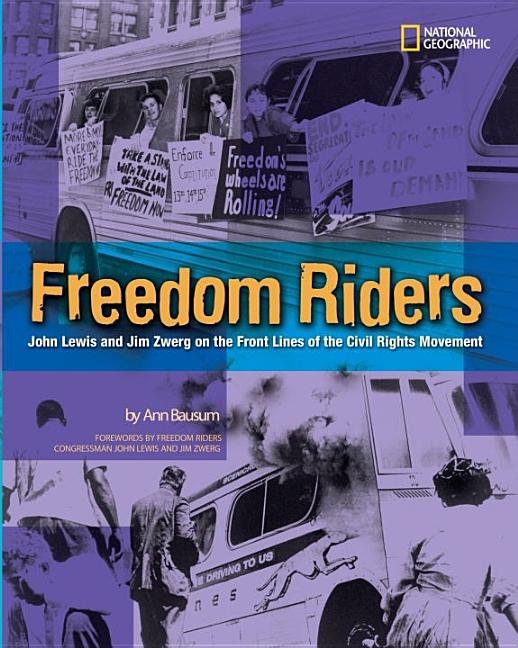Book Descriptions
for Freedom Riders by Ann Bausum
From Cooperative Children's Book Center (CCBC)
John Lewis and Jim Zwerg grew up in startlingly different circumstances, but together they helped change the world. Lewis, who is black, was the son of sharecroppers in Alabama. He attended a segregated, two-room school, and from the time he was young he dreamed of getting on a bus and leaving a state where being black meant so many doors were closed to him. Zwerg, who is white, was the son of a dentist and a homemaker in Appleton, Wisconsin, a community he describes as “lily-white” during his childhood in the 1940s and 1950s. When he attended Beloit College, Zwerg roomed with one of six students of color on the campus and his eyes began to open wide to racism. Like others before them, Lewis and Zwerg, who met in 1961 while both were attending school in Nashville, literally put their lives on the line for justice. They participated in sit-ins to protest segregation in Nashville, and then joined the Freedom Rides. Boarding buses in states that followed federal desegregation laws, Freedom Riders challenged southern states that refused to comply. As the buses crossed the borders of segregated states like Alabama, Freedom Riders cast a national spotlight on the racist social and political systems of the deep south. They were often met by angry, violent mobs, and many local police afforded little or no protection. In chronicling the Freedom Rides through the individual lives and shared experiences of Lewis and Zwerg, Ann Bausum takes readers on a vivid, unforgettable journey into the past. The Freedom Riders’ commitment and passion for justice is palpable, as is the infuriation of those they challenged. Archival photographs (including one of a hospitalized Zwerg after he was badly beaten by a Montgomery, Alabama, mob) illustrate this compelling look at one facet of the Civil Rights Movement. (Ages 10–16)
CCBC Choices 2007 . © Cooperative Children's Book Center, Univ. of Wisconsin - Madison, 2007. Used with permission.
From the Publisher
How did two youths-one raised in an all-black community in the deep South, the other brought up with only whites in the Midwest-become partners for freedom during the civil rights movement of the 1960s? Freedom Riders compares and contrasts the childhoods of John Lewis and James Zwerg in a way that helps young readers understand the segregated experience of our nation's past. It shows how a common interest in justice created the convergent path that enabled these young men to meet. This book introduces young readers (grade 5 and up) to the concept of nonviolent resistance as practiced by Zwerg, Lewis, and their classmates in Nashville, Tennessee. These students broke the color barrier at local movie theaters using this form of protest. Freedom Riders conveys the history of the Freedom Rides through the shared experiences of Lewis and Zwerg. No other book on the subject has used such a personal perspective. These two young men, empowered by their successes in Nashville, were among those who volunteered to continue the Freedom Rides after violence in Anniston, Alabama, left the original bus in flames with the riders injured and in retreat. Lewis and Zwerg joined the cause knowing their own fate could be equally harsh, if not worse, when the Freedom Ride penetrated deeper into the South. When these new participants arrived in Montgomery, Alabama, Zwerg and Lewis were singled out by a mob numbering in the hundreds armed with chains, bats, and hammers. The two youths were nearly beaten to death before police stepped forward to end the violence. The two surviving photographs from their experience provide testimony to the severity of their attacks. Release of these images along with accounts of the violence in Montgomery served to focus national attention on the Freedom Rides. Waves of volunteers came South to continue them. Freedom Riders summarizes the history of the subsequent rides and their success at ending discriminatory seating on Southern interstate bus service. It concludes by relating the divergent paths of Lewis and Zwerg. Lewis rose to prominence with continued participation in the civil rights movement. He became a U.S. Congress member in 1986. Zwerg, at the encouragement of Dr. Martin Luther King, Jr., took up the ministry, a career he continued for 20 years until turning to community service and business. The book is stunningly illustrated with 50 duotoned historical photos and detailed maps. It includes a resource guide of landmarks and references and a related chronology.
Publisher description retrieved from Google Books.


